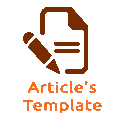ETHNOECOLOGY IN BUYAN LAKE CONSERVATION
DOI:
https://doi.org/10.25078/vidyottama.v8i1.3220Keywords:
cosmos, corpus, praxis, ceremonial means, Lake Buyan conservationAbstract
Ethnoecology is the most recent approach to reveal the complexity of the relationship between belief systems (cosmos), knowledge/cognitive systems (corpus) and praxis (sosio-cultural practices) of local communities which can also be understood as local wisdom. The social phenomena and eco-cultural practices of the people in the Buyan Lake area also show this, so they are appropriately explained on the basis of ethnoecological theory. This qualitative study with descriptive interpretative was carried out for six months (May to October 2023) at the Buyan Lake Area locus. The results of the study show that the people in the Buyan Lake Area really respect the gods who are the rulers of nature who protect the environment of the Buyan Lake Area through the cosmos system, both regarding the mystical belief system revealed in the mythology of the forbidden wood, the gombang-rakrik dragons, the duwe animal, the yellow and the iron soan (springs and channels). Likewise, those who are glorified in the aspect of ruling deities in the Hindu pantheon such as Dewi Danu (lakes gods), Dewi Gangga (river gods), Dewi Gayatri (springs gods), Dewa Vishnu (water gods) and Dewa Sangkara (forest gods). The corpus system concerns their knowledge of the capabilities/availability and utilization of various water resources of Lake Buyan. These two ethnoecological systems form perceptions and underlie practical actions in the form of behavioural adaptations for the conservation of the Buyan Lake Area. The sustainable availability of plant resources around Lake Buyan and its fisheries is also part of its use for periodic rituals (ceremonial means).
References
Ahimsa, P. and Heddy, S. 2007. Ethnoscience, Ethnotech and Etnoart: A Phenimenological Paradigm for Revitalizing Local Wisdom. Yogyakarta: LPPM-UGM.
Ardika, I W. 2015. "The Role of Culture in Preserving Water Resources in Bali". Proceedings of the Symposium on Analysis of Carrying Capacity and Capacity of Water Resources in the Tri-Lake Beratan, Budyan and Tamblingan areas of Bali Province. Denpasar: UPT Plant Conservation Center Eka Karya Botanical Gardens Bali-LIPI.
Candrawan, IBG 2016. Cosmology of Hindu Society in the Tri Danu Area in Environmental Conservation. Dharmasmriti Journal. Vol. XIII Number 26 October 2015: 1 – 135.
Danur, IAS 2005. Ethnoecology of the Landscape of Tenganan Pegringsingan Traditional Village, Bali-Knowledge and Management of Plant Type Diversity by the Bali Aga Community. Dissertation. Depok: Biology Postgraduate Program, Faculty of Mathematics and Science, University of Indonesia, xiii + 259 pp.
Harianto. 2001. Community Perceptions, Attitudes and Behavior towards River Water (Case of the Kaligarang Watershed, Central Java). Dissertation. Bogor. Bogor Agricultural Institute.
Hehanusa, PE 2015. "Spatial Planning and Carrying Capacity of Water Resources in the Beratan-Buyan-Tamblingan Locked Basin, Bali Province". Proceedings of the Symposium on Analysis of the Carrying Capacity and Capacity of Water Resources in the Tri-Lake Area of Beratan, Budyan and Tamblingan, Bali Province. Denpasar: UPT Plant Conservation Center Eka Karya Botanical Gardens Bali-LIPI.
Juliasih, NKA, AAA Sauca Sunia Widyantari, I Nyoman Arsana, & I Putu Gede Suyoga. 2022. The Myth of Danu Bulian: Source of Knowledge for Conservation of Buyan Lake, Pancasari Village, Sukasada, Buleleng, Bali. Denpasar: Presented in International Converence of Interreligious and Inter Culture Studies, Indonesian Hindu University Denpasar.
KLH (Ministry of the Environment). 2008. Lake Ecosystem Management Guidelines. Jakarta: Ministry of the Environment.
Niman, E.M. 2019. Local Wisdom and Efforts to Preserve the Natural Environment. Mission Education and Culture Journal, Volume 11, Number 1, January 2019, p. 1-178.
Poerwanto. 2006. Culture and Environment in Anthropological Perspective. Yogyakarta: Student Library
Saribanon, N. 2007. Participatory Social Planning in Community-Based Residential Waste Management: Case in East Jakarta Municipality Saribanon
Soerjaatmadja, RES 1981. Environmental Science. Bandung: ITB Publishers.
Soerjani, 1987. Environment, Natural Resources and Population in Development. Jakarta: University of Indonesia Press.
Sugiyono. 2011. Educational Research Methods. Bandung: Alphabeta
Sunaryo, TM, T. Walujo, & A. Harnanto. 2007. Water Resources Management Concepts and Applications. Malang: Bayumedia.
Suryadarma, IGP, 2005. Cosmological Conceptions in Usada Taru Pramana Medicine. Journal of Tropical Ethnobiology. Vol. II. No. 1 January 2005. Bogor: LIPI.
Sztompka, P. 2004. The Sociology of Social Change. UK: Blackwell Publishers.
______. 2002. Ethnoecology: A Conceptual Framework for the Study of Indigenous Knowledge of Nature, in JR Stepp, FS Wyndham, and R.K. Zarger (eds), Ethnobiology and Biocultural. Georgia: The International Society of Ethnobiology.
Republic of Indonesia Law. Number 32 of 2009 concerning Environmental Protection and Management


















